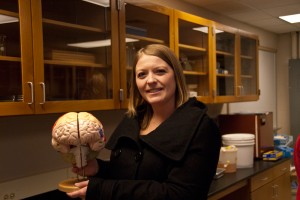By day, I am the web content editor at Elizabethtown College in Elizabethtown, Pa. Our department is behind the scenes working on a completely new college website – huge, huge project. (This explains the strategic launch date of the magazine!) We’re at the point now where we’re gathering content for the new website and part of that is getting new photos.
The Psychology Department at Elizabethtown College invited us to take photos during an interactive class — an honors section was partaking in a brain dissection. Little did the chair of the psychology department know I had such a vested interested in brains. No, no. I’m not a zombie. I promise.
One of my colleagues and I headed to the classroom to take photos of the dissection for use on their new department website and any other digital/print efforts that called for classroom shots. It was fascinating to see these psychology students hard at work. Each team–two students and four blue-gloved hands–had a metal basin filled with metal tools and a sheep brain. At the head of the class was a guest lecturer from the biology department who explained the dissection process on what I think is (or was) a human brain.

Observing the professors demonstrating the dissection to the class. You can see my reflection in the glass door.
As a member of the ‘internal press’, I had to remain professional and not interrupt the lesson; it really took a lot of effort to contain my excitement (which area of the brain is that?). In fact, I showed up in the background of more pictures than I should have! I did, however, whisper to Dr. Lemley that I was launching an online literary magazine called Hippocampus and would love nothing more to see a real, live–well, not-so-live–hippocampus. She’s going to invite me back to look more closely at a human brain and point out the hippocampus. Until then, here I am having fun with a plastic model.
I attended the BODIES exhibit in New York a few years back but was never this close to a brain — the organs there were all behind acrylic walls. Have you been this close to a brain? Share your brain story with us!



1 comment for “My brush with a real, (not so) live hippocampus”